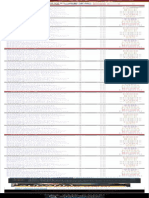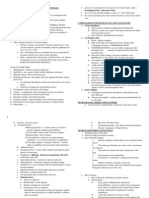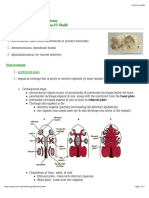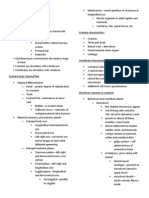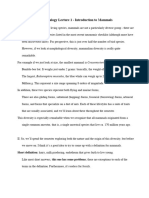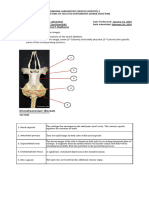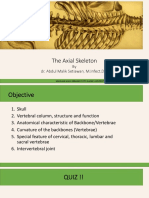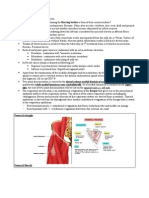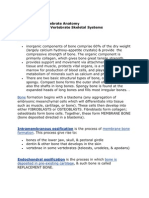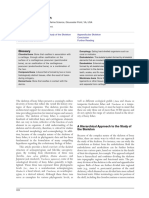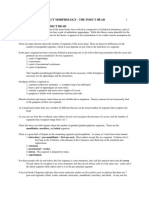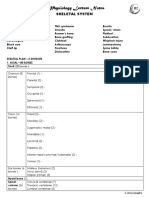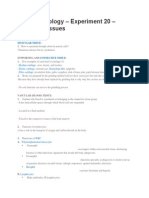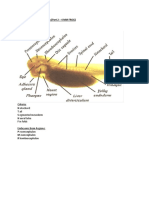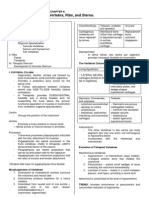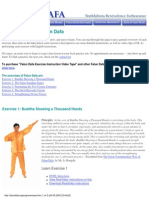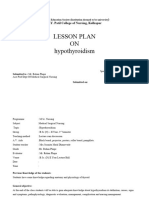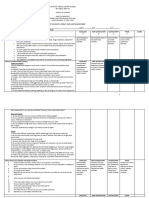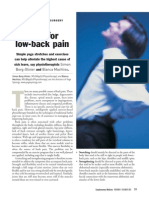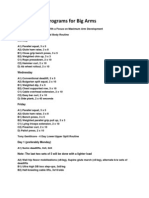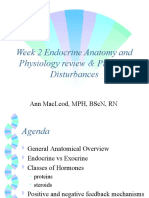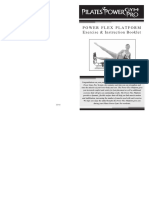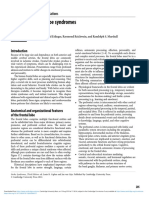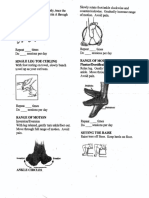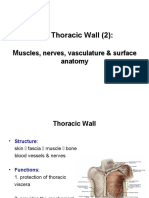Axial Skeleton
Axial Skeleton
Uploaded by
Maureen Peralta TagsaCopyright:
Available Formats
Axial Skeleton
Axial Skeleton
Uploaded by
Maureen Peralta TagsaCopyright
Available Formats
Share this document
Did you find this document useful?
Is this content inappropriate?
Copyright:
Available Formats
Axial Skeleton
Axial Skeleton
Uploaded by
Maureen Peralta TagsaCopyright:
Available Formats
ENDOSKELETON OF VERTEBRATES Axial Skeleton COMPONENTS OF THE ENDOSKLETON CARTILAGE CHONDROGENESIS BONES OSTEOGENESIS DIVISIONS: 1.
1.) AXIAL VERTEBRATES, RIBS, SKULL, HYOID BONE 2.) APPENDICULAR LIMBS, GORDLES, FINS BASIC STRUCTURE OF A VERTEBRAE 1.) ATYPICAL VERTEBRATE 2.) TYPICAL VERTEBRATES A. NEURAL SPINE B. TRANSVERES PROCESS C. NEURAL CANAL D. CENTRUM VERTEBRAE, RIBS AND STERNAE 1.) ARCH 1 OR 2 ARCHES NEURAL ARCH SPINAL CORD FORMS THE HAEMAL CANAL WHICH ENCLOSED THE CAUDAL ARTERY AND VEINS 2.) PROCESSES PROJECTIONS ARCHES CENTRA 3.) CENTRUM BODY OF VERTEBRATES PROCESSESPROJECTIONS FROM ARCHES AND CENTRA 1.) DIAPHOPHYSIS LATERAL PROJECTIONS (TRANSVERSE PROCESS) 2.) ZYGAPOPHYSIS ARTICULATION BETWEEN SUCCESSIVE VERTEBRAE A. PREZYGAPOPHYSIS-DIRECTED ANTERIORLY B. POSTZYGAPOPHYSIS-DIRECTED POSTERIORLY 3.) PARAPOPHYSIS - LATERAL PROJECTIONS FROM THE CENTRA OF FEW TETRAPODS CENTRA OF BICIPITAL RIB (2 HEADED RIBS) 4. )HYPAPOPHYSES MIDVENTRAL PROJECTIONS FROM THE CENTRA OF THE SNAKES AND AMNIOTES
- SITES OF ATTACHMENT FOR CERTAIN MUSCLES AND TENDONS 5.) BASOPOPHYSES CENTRA OF FISHES TYPES OF CENTRUM (BODY) 1.) AMPHICOELOUS CONCAVE AT BOTH ENDS - EX. FISHES, TELEOSTS - CENTRUM IS OCCUPIED BY SOFT NOTOCHORDAL TISSUE 2.) PROCOELOUS CONCAVE ANTERIORLY, CONVEX POSTERIORLY - EX. FROGS 3.) OPISTHOCOELOUS CONCAVE POSTERIORLY, CONVEX ANTERIORLY - EX. REPTILES SALAMANDERS 4.) HETEROCOELOUS SADDLE SHAPED CENTRUM EX.CERVICALVERTEBRAE OF BIRDS 5.) ACOELOUS FLAT CENTRUM AT THE BOTH ENDS EX. MAN VERTEBRAE SKULL: 3 BASIC COMPONENTS 1.) NEUROCRANIUM CHONDRAFACATON/ ENDOSKELETON (PRIMARY BRAINCASE) 2.) DERMATOCRANIUM ROOFING BONES 3.) SPLANCHNOCRANIUM VISCERAL SKELETON 1.) FLOOR OF THE SKULL 2.) ROOF 3.) JAWS
I.
FUNCTIONS OF THE NEUROCRANIUM
1.) PROTECTS THE BRAIN AND SENSE ORGAN
2.) ARISES AS CARTILAGE TO FACILITATE HEAD CIRCUMFERENCE REDUCTION DURING PARTURITION 3.) OSSIFY PARTLY OR WHOLLY AS HARD BONE CARTILALIGINOUS STAGE OF SKULL 1.) PARACHORDAL CARTILAGE ANT. END OF THE NOTOCHORD BENEATH THE MIDBRAIN - INCORPORATED TO THE NOTOCHORD TO FORM BASAL PLATE (SINGLE, BROAD CARTILAGE) 2.) PRECHORDAL CARTILAGE - UNDERNEATH THE FOREBRAIN - EXPANDS AND UNITE ACROSS THE MIDLINE AT THE ANT. ENDS THEN FORM ETHMOID PLATE (FLOOR OF THE SKULL) SENSE CAPSULES: 1.) OLFACTORY (NASAL) CAPSULE SURROUNDING THE OLFACTORY EPITHELIUM 2.) OTIC CAPSULE COMPLETELY SURROUNDING THE OTOCYSTS W/C IS THE DEVELOPING INNER EAR FORAMINA - TRANSMITS NERVES AND VASCULAR CHANNELS 3. OPTIC CAPSULE - FORMS AROUND THE RETINA,ACT AS AN ORBIT - THE SCLEROTIC COAT OF THE EYEBALL - DOES NOT FUSE WITH THE RETINA OF THE NEUROCRANIUM, THUS THE EYEBALL IS FREE TO MOVE INDEPENDENTLY OF THE SKULL - EYE MOVEMENTS: A. SACCADIC C. CONJUGATION B. PURSUIT D. FIXATION SCLERAL RINGS - surrounds the eye and maintain the
shape of the eyeball SCLERA white of the eye, protected by sclerotic coat PLICAE SEMILUNARIS - third eyelid that corresponds to the nictitating membrane of the frogs eye HYPOPHYSEAL FENESTRA accomodates the hypophysis and the internal carotid arteries PRECHORDAL CARTILAGE- trabeculae cranii OSSIFICATION CENTERS 1. OCCIPITAL CENTER - the 4 bones surrounding the foramen magnum - 2 exoccipital, 1 basioccipital, 1 supraoccipital - in man, these 4 bones unite to form the occipital bone with occipital condyles - in modern amphibians, one or more of these bones remain cartilaginous 2. SPHENOID CENTER underlying the brain - BASISPHENOID - ALISPHENOID - PRESPHENOID PLEUROSPHENOID - ORBTIOSPHENOID - In man, these bones are fused forming the single sphenoid bone - in frogs, parasphenoid is the only ossified bone 3. ETHMOID CENTER - SPHENETHMOID in frogs, the sole bone arising from ethmoid and sphenoid - MESETHMOID contributes to the cartilaginous nasal septum in birds and mammals - ECTHETHMOID develop from nasal passageway of sphenodon - TURBINAL BONES (CHONCHAE) - walls of the nasal passgaeways of crocodilians,
birds, and mammals - CRIBRIFORM PLATE in mammals,this is perforated by olfactory foramina which transmit bundles of olfactory nerve fibers from olfactory epihtelium to the brain 4. OTIC CENTER - bones forming the ears a. prootic c.epiotic b. opisthotic d. periotic - in birds and mammals, the 3 bones are fused - in reptiles, opisthotic fused to exoccipital - periotic and squamosal temporal bone DERMATOCRANIUM - Bones closed the Skull (Dermal Bones) - Forms to the top side of the skull - Function: For Protection, serve as roof of the skull - Components: 1. Roofting Bones Fronto Parietal 2. Primary Bone of the Palate 3. Dermal Bone of the Jaw 4. Opecular Bone Fishes - Supraopercular - Preopercular - Interopercular - Large Opercular UPPER JAW - Palaquadrate Cartilage Ossify to form the right and left jaw In Fishes Remains of cartilage for Chondrichthyes & for osteichthyes they Ossify to form the Quadrate bone. Maillae & Premaxillae Tooth Bearing of Bones
Primary Palatal Bone Roof of the Dropharyngeal cavity of the fishes & of the oral cavity of tetrapods. Contd.. Components: 1. Parasphenoid Unpaired Bone 2. Vomers 3. Palatine 4. Pterygoids 5. Ectopherygoids 6. Choanae Internal Nares FUSION OF NEUROCRANIUM AND DERMATOCRANIUM 1. FISHES - Cyclostomes and Amia remains cartilaginous - Garfishes ossifies - Roofing Bones of the bony Fishes 1. frontal 2. supraoccipital 3. parietal 4. postemporal 2. AMPHIBIANS - Anurans and urodeles, the neurocranium remains cartilaginous -in apodans, it is ossified fro burrowing - anurans are with platybasic skull 3. REPTILES - with ossified neurocranium, dentary, and occipitals - temporal fossae a partial complete secondary palate - temporal fenestra cavernous opening of temporal region of amniotes TYPES OF TEMPORAL FOSSAE 1. ANAPSIDS no temporal fossae - ex. Dinosaurs 2.SYNAPSIDS with one temporal fossae
- ex. Extinct reptiles with 2 temporal fossae - living reptiles,crocodiles,sphenodon 4. EUROPSIDS with one lateral temporal fossae - ex. Extinct reptiles *** TURTLE- with enigmatic skull - no temporal fossae, loss dermal bones 4. AVES - ossified bone, bulging outward forming TROPIBASIC SKULL - bones forming the beaks - upper jaw * maxillae,premaxillae,nasals - lower jaw * dentary - 2 functional regions of the skull 1. solid bony box (neurocranium & dermatocranium) - houses the brain,olfactory organs, eyeball, and hearing and equilibrium complex 2. elongated beak - procuring and handling area 4. MAMMALS - skulls are with fontannels - modifications: 1. dentary forms the mandible - the only movable bone of the lower jaw 2. temporal region 2 3. altered side secondary palate pterygoid bone auditory ossicles 3.DIAPSIDS * malleus, incus,
stapes CRANIAL KINESIS The independent movement of parts of the skull The condition in which snakes swallow food due to presence of ectopterygoid bone In mammals ectopterygoid is lost, the styloid process is left, located in the visceral skeleton III. SPLANCNOCRANIUM Skeleton of the pharyngeal arches In fishes the skeleton of jaws, gill arches The balstemas are from the neural crests and arise from the neuroectoderm MODIFICATION OF THE SPLANCNOCRANIUM 1. CYCLOSTOMES - unique visceral skeleton - no palatpqudrate or merkels cartilage - a cartilaginous branchial basket located at the base of the skin of the pharyngeal arch 2. BONY FISH - visceral skeleton resembles that of the shark except that is ossifies - hyoid arc consist of a larger number of components TYPES OF JAW SUSPENSION A. HYOSTYLIC fishes - hyomandibular cartilage is braced against the otic capsule - posterior end of the palatoquadrate is braced against the hyomandibula B. AMPHISTYLIC older sharks - hyomandibula and one or more processes of palatoquadrate are braced independently against the braincase C. AUTOSTYLIC - lungfishes and tetrapods - palatoquadrate is attached independently against the braincase 3. AMPHIBIANS - Palatoquadrate is enclosed by the membrane bone and its caudal end become quadrate bone
Merkels cartilage are invested, caudal ends become the articular bone In anurans, hypomandibula become the columella & the remainder of the 2nd,3rd,part of the 4th arch become the HYOID SKELETON 4TH & THE 5TH become the cartilage of the larynx 4. MAMMALS - Articular and quadrate bones become ossicles of the middle ear (malleus and incus)
You might also like
- Socket PreservationDocument24 pagesSocket PreservationFadly Rasyid100% (1)
- Jim Stoppani - Oxford Drop SetDocument1 pageJim Stoppani - Oxford Drop SetDanCurtisNo ratings yet
- Comparative Anatomy of Vertebrate SkeletonDocument53 pagesComparative Anatomy of Vertebrate SkeletonYlane Lee100% (2)
- Axial Skeleton, ENDOSKELETON OF VERTEBRATESDocument52 pagesAxial Skeleton, ENDOSKELETON OF VERTEBRATESDave MarimonNo ratings yet
- Neurocranium PDFDocument7 pagesNeurocranium PDFRobelle CordovaNo ratings yet
- Lecture Note - Skull and Visceral SkeletonDocument4 pagesLecture Note - Skull and Visceral SkeletonLopez Manilyn CNo ratings yet
- 09 Skull and Visceral SkeletonDocument6 pages09 Skull and Visceral SkeletonKaye Coleen Cantara NueraNo ratings yet
- Chapter 9 SKULLDocument4 pagesChapter 9 SKULLGelyn Lanuza-Asuncion100% (1)
- Skeletal Urogenital Lecture ComparativeDocument136 pagesSkeletal Urogenital Lecture ComparativeLei Jenevive UmbayNo ratings yet
- Vertebrate Systems SummaryDocument29 pagesVertebrate Systems SummaryHazel Grace Bellen100% (1)
- Zoology MidtermsDocument14 pagesZoology MidtermsJULIANNE ANACTANo ratings yet
- 2 Skeletal PDFDocument7 pages2 Skeletal PDFvada_soNo ratings yet
- Skeletal System. SkullDocument24 pagesSkeletal System. SkullJessa Belle100% (1)
- Bio 3 BlabskeletonDocument12 pagesBio 3 BlabskeletonChucksters79No ratings yet
- Skeletal SystemDocument8 pagesSkeletal SystemAbby VillamuchoNo ratings yet
- SkullDocument11 pagesSkullGeorgeNo ratings yet
- 10 Girdle, Fins, Limbs, and LocomotionDocument4 pages10 Girdle, Fins, Limbs, and LocomotionKaye Coleen Cantara NueraNo ratings yet
- Chapter 1: IntroductionDocument2 pagesChapter 1: IntroductionTrisha RosalesNo ratings yet
- LECTURE GUIDE Skeletal SystemDocument9 pagesLECTURE GUIDE Skeletal SystemjandaniellerasNo ratings yet
- Skeletal SystemDocument52 pagesSkeletal SystemHarish musictryNo ratings yet
- 2 - Comparative Vertebrate AnatomyDocument35 pages2 - Comparative Vertebrate AnatomyGlen Mangali100% (1)
- 2nd Grading Activity SheetsDocument22 pages2nd Grading Activity SheetsXella RiegoNo ratings yet
- The Skull and Vicsceral Skeleton PDFDocument13 pagesThe Skull and Vicsceral Skeleton PDFAmberValentineNo ratings yet
- 2ND Grading Laboratory SheetsDocument16 pages2ND Grading Laboratory SheetsAllecia Leona Arceta SoNo ratings yet
- Exercise 4: Skeletal SystemDocument8 pagesExercise 4: Skeletal SystemstevemacabsNo ratings yet
- Skeletal SystemDocument11 pagesSkeletal SystemCrystal MaidenNo ratings yet
- Lecture 1Document5 pagesLecture 1shadow143No ratings yet
- Lab II 09studentDocument7 pagesLab II 09student03152788No ratings yet
- Skeletal SystemDocument7 pagesSkeletal SystemKatherineNo ratings yet
- Complab Exercise 2 SharkDocument9 pagesComplab Exercise 2 SharkstephaniealmendralNo ratings yet
- Kul 12Document43 pagesKul 1221-221 Atha MaulanaNo ratings yet
- LabSci1 Lab Ex15Document10 pagesLabSci1 Lab Ex15Hannah Mondilla100% (1)
- Anatomy LecturesDocument3 pagesAnatomy LecturesalllexissssNo ratings yet
- Compa SkeletalDocument37 pagesCompa SkeletalJamie LiwanagNo ratings yet
- AnatomyDocument45 pagesAnatomyrkoppikarNo ratings yet
- Anaphy Midterm Reviewer1Document14 pagesAnaphy Midterm Reviewer1juddee.conejosNo ratings yet
- Lab II 09StudentQADocument17 pagesLab II 09StudentQAgalaxy113No ratings yet
- Bio 102 Lab Outline - Skeletal System Cranial Skeleton: Ribs As Modified False Ribs With Hanging Sternal RibDocument1 pageBio 102 Lab Outline - Skeletal System Cranial Skeleton: Ribs As Modified False Ribs With Hanging Sternal RibkadiNo ratings yet
- Bio 342Document76 pagesBio 342Steph VeeNo ratings yet
- Otology NotesDocument861 pagesOtology Notesmkk26rss2f100% (1)
- Skeletal SystemDocument7 pagesSkeletal Systemvincealgarme09No ratings yet
- CHNCGDocument7 pagesCHNCGDANIEL LANCE NEVADONo ratings yet
- Anatomy BonesDocument11 pagesAnatomy BonesDunkin DonutNo ratings yet
- Skeleton Ikan IIDocument15 pagesSkeleton Ikan IIYvonee XaviersNo ratings yet
- Week 03a Insect HeadDocument5 pagesWeek 03a Insect HeadVanshika ChaudharyNo ratings yet
- Human Anatomy and Physiology Lecture Notes: Skeletal SystemDocument5 pagesHuman Anatomy and Physiology Lecture Notes: Skeletal SystemRexmark VidalNo ratings yet
- Chapter 8Document4 pagesChapter 8Mariecris SeñoNo ratings yet
- Comparative Vertebrate Anatomy ReviewerDocument3 pagesComparative Vertebrate Anatomy ReviewerJohn Rudolf CatalanNo ratings yet
- Tissue 2Document34 pagesTissue 2nneduchiemerieNo ratings yet
- The Endoskeleton of Birds.Document29 pagesThe Endoskeleton of Birds.Ian LasarianoNo ratings yet
- Bio 11 - Zoology - Experiment 20 - Types of Tissues: Muscular TissueDocument17 pagesBio 11 - Zoology - Experiment 20 - Types of Tissues: Muscular TissueDenise Cedeño100% (1)
- SKULLDocument3 pagesSKULLCHRISTINA- Malana, Marianne LibertyNo ratings yet
- Anatomy of H&NDocument98 pagesAnatomy of H&NAhmed ZakiNo ratings yet
- Wk2 Head and Neck Anatomy TutorialDocument4 pagesWk2 Head and Neck Anatomy Tutorialamatthews800No ratings yet
- Bio 85Document17 pagesBio 85karinadawn.remaciaNo ratings yet
- Embryo Lab Org 2Document14 pagesEmbryo Lab Org 2pauNo ratings yet
- 1 Animal DiversityDocument31 pages1 Animal DiversityAnjan Tej NayakNo ratings yet
- Osteology Osteology Is The Study of Bones That Are Considered The Framework of The BodyDocument40 pagesOsteology Osteology Is The Study of Bones That Are Considered The Framework of The BodybingchillingNo ratings yet
- 08 Vertebra, Ribs, and SternaDocument3 pages08 Vertebra, Ribs, and SternaKaye Coleen Cantara Nuera100% (1)
- Qi Gong - Falun Dafa ExercisesDocument32 pagesQi Gong - Falun Dafa ExercisesAntonio Lemus83% (6)
- Sample Case: EndocrinologyDocument42 pagesSample Case: EndocrinologyCoy NuñezNo ratings yet
- Hypo LPDocument15 pagesHypo LPSusmita SawardekarNo ratings yet
- Mouth Assessment RubricDocument5 pagesMouth Assessment RubricChris SmithNo ratings yet
- MC Chapter 48 TestDocument14 pagesMC Chapter 48 Testbori0905100% (2)
- Yoga For Back PainDocument5 pagesYoga For Back Painaadityabuggascribd100% (1)
- Patient LoadDocument6 pagesPatient LoadJoanna EdenNo ratings yet
- 3 Total Body Programs For Big ArmsDocument4 pages3 Total Body Programs For Big ArmsRyan Pan100% (1)
- Week 2 Endocrine Anatomy and Physiology Review & Pituitary DisturbancesDocument27 pagesWeek 2 Endocrine Anatomy and Physiology Review & Pituitary DisturbancesZiqri Dimas SandyNo ratings yet
- (Board Review Series) Kyung Won Chung - BRS Gross Anatomy (2004, Lippincott Williams - Wilkins) - Libgen - LiDocument17 pages(Board Review Series) Kyung Won Chung - BRS Gross Anatomy (2004, Lippincott Williams - Wilkins) - Libgen - LiSalifyanji SimpambaNo ratings yet
- Ier Pe ADocument27 pagesIer Pe ATrixia Delgado100% (1)
- Csir Net Life Science Unit 7 SyllabusDocument2 pagesCsir Net Life Science Unit 7 Syllabusballubhai2626No ratings yet
- Lab Activity 23: Cardiac AnatomyDocument31 pagesLab Activity 23: Cardiac Anatomyadjie89No ratings yet
- Power Flex Platform Exercise & Instruction BookletDocument12 pagesPower Flex Platform Exercise & Instruction Bookletfronjose100% (1)
- Rodney King Autopsy ReportDocument29 pagesRodney King Autopsy ReportRichard Donald Jones100% (2)
- E5 - Ulnar NerveDocument2 pagesE5 - Ulnar NerveAnonymous aeXhh3Ba17No ratings yet
- Nursing Care Management 101 Health Assessment: Procedural Checklist inDocument5 pagesNursing Care Management 101 Health Assessment: Procedural Checklist inKyle Randolf CuevasNo ratings yet
- Frontal Lobe SyndromesDocument7 pagesFrontal Lobe SyndromespiedrahitasaNo ratings yet
- Oral Anatomy FinalDocument7 pagesOral Anatomy FinalGlassyNo ratings yet
- Medical I.I Center: Ankle AlphabetDocument2 pagesMedical I.I Center: Ankle Alphabetjamie vNo ratings yet
- Practice Quiz: Special Senses Anatomy and Physiology: Nursing Test Bank NCLEX Practice QuestionsDocument32 pagesPractice Quiz: Special Senses Anatomy and Physiology: Nursing Test Bank NCLEX Practice QuestionsLelah Faye VidalNo ratings yet
- Gigantism Pcol Jan26,2024Document20 pagesGigantism Pcol Jan26,2024Nur Raineer laden GuialalNo ratings yet
- AL Category 3 Training PDFDocument70 pagesAL Category 3 Training PDFSean StreetNo ratings yet
- Radiography of Forearm and Upper ArmDocument35 pagesRadiography of Forearm and Upper ArmsaurabhmhshwrNo ratings yet
- Siemens TSH3 Ultra IFU 17.05.19Document14 pagesSiemens TSH3 Ultra IFU 17.05.19Chris ThomasNo ratings yet
- Chapter 12 Heart ReviewerDocument8 pagesChapter 12 Heart ReviewerPhilline ReyesNo ratings yet
- Assignment 2 FingerprintsDocument6 pagesAssignment 2 Fingerprintsapi-238531681No ratings yet
- Anatomy, Lecture 4, Thoracic Wall (2) (Slides)Document23 pagesAnatomy, Lecture 4, Thoracic Wall (2) (Slides)Ali Al-QudsiNo ratings yet

